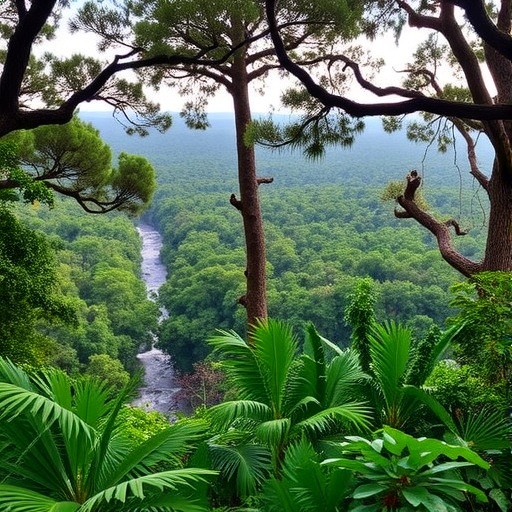In the heart of the eastern Democratic Republic of Congo lies a pivotal ecosystem—Kahuzi Biega National Park. This UNESCO World Heritage site is not only home to extraordinary biodiversity but also serves as an essential ecological buffer amid the dynamic environmental changes occurring globally. Recent research conducted by notable scientists, including Cirezi, Mugumaarhahama, and Useni, has shed new light on the spatial patterns and ecological drivers of tropical moist forest transitions within this vital landscape.
The study emphasizes the complex interplay between various ecological factors that influence the transition zones in tropical moist forests. These transitions are critical, serving as indicators of broader ecological shifts that can provide foresight into the health of forests across the globe. In their research, the authors deployed an array of analytical techniques to unravel the intricate mosaic of biotic and abiotic influences that govern forest patterns.
One of the significant findings from this research is the role of climate variability in shaping the forest ecosystems within Kahuzi Biega. With climate change accelerating, understanding these variabilities is crucial, as they can lead to alterations in species distribution and overall forest structure. The researchers highlighted that shifts in temperature and precipitation patterns have a direct correlation with the extent of forest cover in specific regions of the park.
Moreover, the study underscores the importance of soil characteristics as pivotal ecological drivers. Rich, nutrient-dense soils provide the foundation for diverse plant communities. The authors meticulously documented soil types across various elevations within the park, revealing how these variations affect moisture retention and overall ecosystem productivity. Knowledge of these soil properties is indispensable for conservation strategies aimed at preserving this unique environment.
Another critical aspect of the study involves the interplay of anthropogenic influences on these natural systems. The research team meticulously examined the impact of human activities, such as agriculture and deforestation, on forest transitions. They observed that proximity to human settlements often leads to significant changes in forest composition, which poses threats to native species and their habitats.
In addition to anthropogenic factors, species interactions are pivotal to understanding the transitions within moist forests. Cirezi and colleagues conducted extensive field studies to catalogue species interactions, unveiling the complex web of relationships that exist between flora and fauna. These interactions are central to the resilience of forest ecosystems, as they contribute to ecological stability and the preservation of biodiversity.
The methodology employed in this investigation included advanced remote sensing technology, which allowed the researchers to map forest cover changes over time accurately. This high-resolution data has only become possible in recent years, demonstrating the power of technology in ecological research. With the ability to identify transitions from various forest types, the researchers could better understand the dynamics and trajectories of these ecosystems in the face of ongoing onslaughts from climate change.
Such foundational research is essential, not just for Kahuzi Biega, but for tropical forests worldwide. The methodologies and findings can serve as a guide for other researchers working on forest transitions in different regions, emphasizing the necessity for tailored conservation strategies that consider locality-specific factors. Each tropical moist forest has unique ecological characteristics that can impact conservation outcomes.
As the study draws attention to the pressing need for conservation efforts in the Kahuzi Biega National Park, it raises questions about the future of these biodiverse ecosystems. The authors argue for immediate actions aimed at mitigating the adverse effects of climate change and human activities. Enhanced policy frameworks that integrate scientific data into management strategies are paramount if the remarkable diversity of Kahuzi Biega is to be preserved for future generations.
The research not only provides a snapshot of the current state of forest transitions but also looks ahead to future outcomes. By predicting potential scenarios based on existing data, the authors offer invaluable insights into how climate and ecological interactions may evolve over the coming decades. This predictive capacity is essential for preparing effective responses to impending environmental changes that could compromise forest integrity.
As discussions around climate resilience become increasingly pronounced, this study serves as a clarion call to recognize the intrinsic values of tropical forests. The ecosystem services they provide, including carbon storage, water regulation, and habitat provision, are irreplaceable. Emphasizing this can galvanize local communities, policymakers, and global stakeholders to invest in sustainable practices that honor and protect these vital ecosystems.
In conclusion, the research conducted by Cirezi, Mugumaarhahama, and Useni encapsulates a wealth of information regarding the complexities of tropical moist forest transitions in Kahuzi Biega National Park. Their findings emphasize the need for a multi-faceted approach to conservation—one that accounts for the myriad forces at play in influencing forest dynamics. As external pressures mount and ecological uncertainties loom, the insights gleaned from this research become increasingly crucial for the future of tropical moist forests.
With the stakes higher than ever, this latest exploration into the ecological nuances of Kahuzi Biega National Park illuminates a path forward, one that combines rigorous scientific analysis with actionable conservation strategies. Protecting these invaluable ecosystems is not merely an environmental obligation; it’s imperative for safeguarding our planet’s biodiversity and sustaining the vital functions that these forests provide.
Subject of Research: Ecological drivers of tropical moist forest transitions
Article Title: Spatial patterns and ecological drivers of tropical moist forest transitions in the Kahuzi Biega National Park landscape, eastern Democratic Republic of Congo
Article References:
Cirezi, N.C., Mugumaarhahama, Y., Useni, Y.S. et al. Spatial patterns and ecological drivers of tropical moist forest transitions in the Kahuzi Biega National Park landscape eastern Democratic Republic of Congo.
Discov. For. 1, 43 (2025). https://doi.org/10.1007/s44415-025-00046-9
Image Credits: AI Generated
DOI:
Keywords: Forest ecology, Kahuzi Biega National Park, climate change, biodiversity, conservation strategies.




